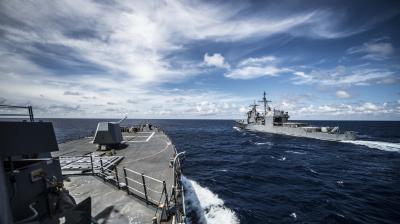The United States' Dangerous Game in the South China Sea
New maritime incidents have recently occurred in the South China Sea between China and some of its South-East Asian neighbours. On several occasion in recent months, Chinese patrol ships have prevented Philippine and Vietnamese vessels from exploring for oil and gas in disputed waters. While each side claims that it has acted in accordance with its sovereign rights, the result is that China’s relations with its two neighbours have become tense. Moreover, Asia’s rapidly expanding multilateral security architecture has not prevented these rising tensions. On the contrary, the regional security architecture seems to be undermining stability in the South China Sea area, which is a newly emerging hot spot in Asian security affairs. A particular cause for concern is the way in which the United States is using these multilateral forums to respond to the rise of China.
New Multilateral Forums and the South China Sea
The multilateral system of security mechanisms in the Asia-Pacific region is expanding rapidly. Two longer-existing regional security forums, the ASEAN Regional Forum (ARF) and the Shangri-La Dialogue, have been complemented with the ASEAN Defence Ministers’ Meeting Plus (ADMM+). The inaugural meeting of ADMM+ took place in October 2010 in Hanoi, Vietnam. In addition, in November 2011 Russia and the United States will join the annual East Asia Summit (EAS) as full members. While the EAS was formerly focused mostly on economic cooperation, the United States has announced that it will use the EAS to discuss security issues in the Asia-Pacific region. The ADMM+ and the expanded EAS constitute a new set of ‘ASEAN+8’ security forums.
Two security issues have been existing side by side in the South China Sea: on the one hand, a territorial dispute that involves China and the other littoral states (Taiwan, Vietnam, the Philippines, Malaysia and Brunei); and on the other hand, a growing degree of maritime rivalry between China and the United States. Until recently, these two issues were not connected in a direct way. However, at the ARF ministerial meeting in July 2010, US Secretary of State Hillary Clinton established a linkage when she stated that the United States has a national interest in freedom of navigation in the South China Sea, that the United States believes that the territorial disputes between China and its neighbours should be solved collectively, and that Washington is prepared to facilitate this process. In October 2010, similar statements were made by US Secretary of Defense Robert Gates at the ADMM+ and by Secretary Clinton at the EAS. Asia’s multilateral security mechanisms have provided the United States with an opportunity to establish itself as a party in the territorial disputes between China and its neighbours. Although many South-East Asian countries welcome Washington’s greater involved in regional affairs, they are also wary of becoming caught up in a Sino-US conflict.
Washington’s Declining Capability to Contribute to Regional Stability
As China becomes stronger, the United States is under increasing pressure to show its allies and partners in Asia that it is still committed to, as well as capable of, exerting influence in the region. This is the key issue underlying the Obama administration’s policy of ‘returning’ to Asia. That the United States is back and intending to stay was clearly articulated in a recent speech by Secretary Gates at the 2011 Shangri-La Dialogue. The United States has long regarded itself as the guarantor of peace and stability in the Asia-Pacific region. Providing such a ‘common good’ legitimizes the influential role of the United States in Asian affairs. However, the question arises as to whether Washington will be able to continue its traditional security role in Asia. While China’s rise may increase the other regional countries’ demand for counterbalancing by the United States, at the same time it also limits the United States’ ability to counter Beijing’s influence.
The enlarged US involvement in the South China Sea is likely to encourage regional countries such as Vietnam and the Philippines to pursue their national interests, even if this means defying China. These South-East Asian countries know that time is to Beijing’s advantage: their claim position deteriorates as China becomes stronger. They may therefore judge it to be strategically useful to benefit from US pressure on China while it lasts. The recent incidents relating to Vietnamese and Philippine efforts to explore for oil and gas point in this direction. Beijing has maintained its territorial claims in the South China Sea since the 1940s. Although China is patient about solving the territorial disputes, it is very unlikely that it will tolerate any change in the status quo that harms its claim position. New oil and gas exploration activities—especially those involving Western companies—may be perceived as changes to the status quo. This is a high-priority matter for Beijing, and China is increasingly able to protect its interests by military means.
Should the United States be able to deter China from acting forcefully against its neighbours, then its greater involvement could result in greater stability in the region. However, China is rapidly becoming too strong—not just economically and diplomatically but also militarily—for the United States to maintain an unquestionable capacity to intervene successfully if necessary. Against this background, it seems more likely that Washington’s approach would have a destabilizing effect on the South China Sea. Not only is there an increased risk of conflict between China and one of its neighbours, but ultimately also of a crisis in Sino-US relations. For the United States to play a truly stabilizing role, it would need to take measures aimed at discouraging not just China but also China’s neighbours from adopting provocative policies. Moreover, given that the United States and China are geopolitical rivals, such a role would also require refraining from linking the regional territorial disputes to the United States’ own maritime interests in the region.
This article was published on Clingendael Asia Forum.





